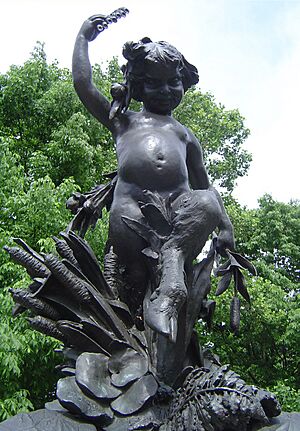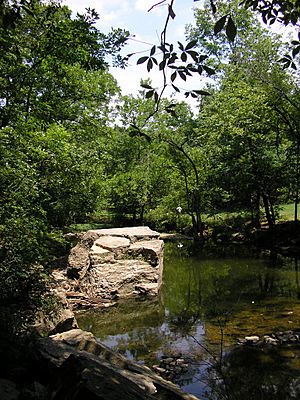Cherokee Park facts for kids
Quick facts for kids Cherokee Park |
|
|---|---|

Cherokee Park, Baringer Hill
|
|
| Type | Municipal |
| Location | East Louisville, Kentucky |
| Area | 409 acres (166 ha) |
| Created | 1891 |
| Operated by | Louisville Metro Parks |
Cherokee Park is a huge 409-acre (166 ha) park in Louisville, Kentucky, United States. It's a key part of the Louisville Olmsted Parks system. A famous park designer named Frederick Law Olmsted created it in 1891. He also designed 18 other parks in Louisville!
A stream called Beargrass Creek flows through the park. Many bridges cross it for both cars and people.
About 500,000 people visit Cherokee Park every year. This makes it one of the most popular city parks in the United States.
The park has a 2.4-mile "Scenic Loop." This loop goes through pretty areas with rolling hills, open fields, and forests. It used to have separate lanes for cars and people. However, since April 2020, the loop has been closed to cars. This helps people have more space for walking and biking.
Contents
Discovering Cherokee Park's Past
Cherokee Park first opened in 1891. It quickly became a popular spot and helped new neighborhoods grow nearby.
How the Park Land Was Chosen
The land for Cherokee Park was once part of a huge 4,000-acre (16 km2) area. This land was given to James Southall and Richard Charlton in 1773.
One part of the land, about 43-acre (170,000 m2), was later owned by Archibald P. Cochran. He built a large estate there called Fern Cliff. This estate was even a museum for a while, but it's gone now.
The land around Beargrass Creek was very hilly. This made it hard to farm. So, before it became a park, people mostly used the land for animals to graze. By 1893, the land was divided into six big properties. The city bought Cochran's land after he passed away in 1889. Over time, the city bought more land from other families to make the park its current size.
Building the Park and Its Challenges
In 1887, people suggested creating a city park system. They wanted three large parks: one in the east, one in the west, and one in the south. The eastern park was first called Beargrass Park. But in 1891, they chose the name Cherokee Park. This name was popular at the time and sounded like Native American imagery.
Cochran Hill in the park is named after Archibald P. Cochran. In the late 1960s, two tunnels were dug under this hill. This was done so that I-64 would not cut through the park too much. These tunnels are about 425 feet (130 m) long. Groups like "Save Our Parks" worked hard to protect the park from highways. They helped make sure the tunnels were built as a compromise.
The tunnels opened in 1970. They are considered very important by the government. This means it will be very hard to make the highway wider through the park.
In 2010, the city wanted to replace the Hogan's Fountain Pavilion. But people in the community disagreed. They raised money to fix the old building instead of replacing it.
The 1974 Tornado and Rebuilding Efforts
On April 3, 1974, a huge tornado hit the park. It was part of the 1974 Super Outbreak. This tornado was an F4, which is very powerful. It caused a lot of damage to the park. Many thousands of old trees were lost. A city expert said that no one alive would see the park as it was before the storm.
After the tornado, a big effort began to replant the park. The United States government gave money to help. To get the money, the park had to be rebuilt to look as much like its original design as possible. Workers used Frederick Law Olmsted's original plans to "rebirth" the park. They planted 2,500 trees and 4,600 shrubs to bring it back to life.
Exploring Famous Spots in Cherokee Park
Cherokee Park has many interesting places to visit. Many of these spots are like small areas within the bigger park. They are separated by hills, trees, and smart landscaping. Because the park is so big and well-designed, many different activities can happen at the same time without bothering each other.
- Big Rock – This is a large rock in Beargrass Creek. It's also the name of a picnic area and playground nearby. People use the rock for picnics. There's also an open shelter building built in 1910.
- Scenic Loop – This is a 2.43-mile (3.9-km) road that goes around much of the park. It has separate lanes for people walking or biking and for cars (though cars are currently not allowed).
- Frisbee Field – A large open field. People use it for many sports, like soccer and Ultimate Frisbee.
- Baringer Hill – Often called "Dog Hill" or "Kite Hill." It was once popular for flying kites. After being updated in the late 1990s, it became a popular spot for dog owners. A fenced dog park opened on Cochran Hill in 2007.
- Hogan's Fountain – This fountain is on a hill along the Scenic Loop. The Hogan Family paid for it in 1905. It was made by a sculptor named Enid Yandell. The fountain has a statue of the Greek God Pan. The area around the fountain is also called Hogan's Fountain. It has a large gazebo, a baseball field, kids' fountains, and a basketball court. This spot is great for group meetings and picnics.
- Lover's Lane – A quiet, wooded part of the Scenic Loop, just past Hogan's Fountain.
- Cochran Hill – A hillside between Frisbee Field and Lexington Road. It's also where the dog park is.
- Christensen Fountain – A recently fixed-up fountain near the Lexington Road entrance.
- Nettleroth Bird Sanctuary – A peaceful area in the park, good for birdwatching.
- Belknap Bridge – This stone bridge was built by Col. Morris Burke Belknap in 1893. He built it to honor his wife, Lily Buckner Belknap, after she passed away.
Getting Into the Park
The park is located in an area called The Highlands. As Louisville grew, many builders gave land to the park. In return, they could connect roads to the park. Because of this, the park has many entrances. This can sometimes make it confusing for visitors to find their way around. Some neighborhoods with entrances to the park include Cherokee Triangle, Bonnycastle, Highlands-Douglass, Crescent Hill, and Seneca Gardens.
Fun Things to Do in Cherokee Park
Cherokee Park offers many different activities and features for everyone to enjoy:
- Archery range – A place to practice archery near Beals Branch Road.
- Ballfield – Located at Hogan's Fountain, great for baseball.
- Baringer Spring – A pretty stream with wooden bridges and walking paths.
- Basketball court – A full-court basketball area at Hogan's Fountain.
- Bike trails – Trails throughout the park, crossing the scenic loop. The loop itself is popular for road biking.
- Bridle trail – A trail for horseback riding.
- Golf course – A 9-hole golf course that opened in 1907.
- Hiking trails – Trails that can be used for walking, running, or biking.
- Horseshoe pits – At Hogan's Fountain, for playing horseshoes.
- Picnic pavilions – Large, pagoda-style buildings at Hogan's Fountain for gatherings.
- Picnic tables – Many tables for picnics at and near Hogan's Fountain.
- Playgrounds – Fun play areas for kids at Hogan's Fountain, Big Rock, and Baringer Hill.
- Rugby field – Also used for Frisbee and soccer.
- Restrooms – Available at Baringer Hill, Hogan's Fountain, and Big Rock.
- Spray pool – A water play area at Hogan's Fountain.
- Willow Pond – A pond off Grinstead Drive, next to the golf course. It's stocked with different types of fish like bass, bluegill, and trout.
- Gravity hill – A spot on the Scenic Loop where it feels like you're rolling uphill when you're actually going down!
- Dog run – A fenced area for dogs, opened in August 2007, located on Cochran Hill.
Activities You Can Do
Cherokee Park is a great place for many outdoor activities:
- Walking and hiking
- Running and jogging
- Playing golf
- Walking your dog (especially at Baringer Hill, or "Dog Hill")
- Riding bikes on trails and roads
- Fishing in Willow Pond
- Sledding in winter
- Having picnics
- Playing baseball, basketball, football, rugby, and soccer
- Playing Ultimate Frisbee
- Geocaching (a treasure hunt game using GPS)
- Archery
- Sometimes, people even have weddings here!
- Live action role-playing (LARP)
- Ham radio events, like ARRL Field Day in June
Plants and Animals in the Park
Cherokee Park is home to many different kinds of wildlife and plants. You might see Eastern white-tailed deer, raccoons, gray foxes, opossums, groundhogs, and squirrels. There are also snapping turtles, eastern box turtles, garter snakes, and red-tailed hawks. You might even spot beavers or the Louisville crayfish! Many different songbirds visit the park too. A book about the plants in Cherokee Park was released in 2014.
More recently, people have seen coyotes in the park. A magazine article from 2016 said that Cherokee Park is like a "Costco for coyotes." This means it has lots of squirrels, mice, and chipmunks for them to eat, water to drink, and plenty of places to hide.
See also





